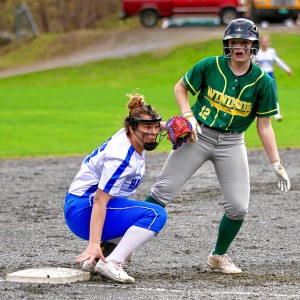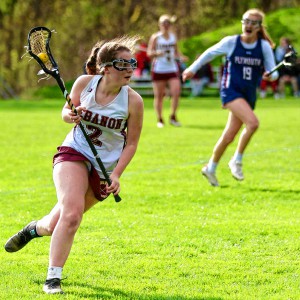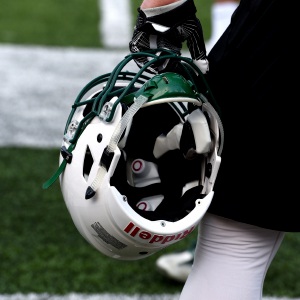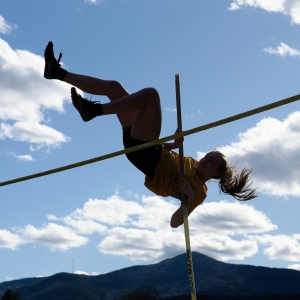‘Absolutely amazing’: A year after painful crash, race car driver back on track
| Published: 05-22-2023 7:26 PM |
CLAREMONT — A steering wheel hangs on a wall of the garage used by 37-year-old race car driver Tyler Lescord.
The once-circular wheel — one of the few parts salvaged from the wreckage of his serious crash a year ago at Claremont Motorsports Park — is now gruesomely misshapen, with one arc collapsed inward by the impact of Lescord’s body during the terrifying mishap.
“I don’t think I ever let go of the wheel,” he said in an interview earlier this month.
It was on April 29, 2022, as Lescord was driving in a Late Model series race that he and another driver clipped wheels on the front stretch. It caused Lescord’s car to veer sharply into a concrete retaining wall at more than 80 miles per hour.
Lescord said he began piecing together memories of the collision only after watching a video recording during his recovery.
“A bad scenario is the best way to describe it,” Lescord explained. He said he was trying to allow the other driver to pass, but the competitor’s car drifted into Lescord’s path.
Last month, on almost exactly the one-year anniversary of his crash, Lescord was back in the driver seat at Claremont Motorsports Park, running test laps before the races on April 28.
Then on May 12, Lescord completed his first race of the season, finishing fourth out of six cars in a 25-lap contest.
Article continues after...
Yesterday's Most Read Articles
“It felt absolutely amazing to be driving again,” Lescord said. “It was nice being back in the environment again.”
Some of Lescord’s friends were surprised that he would return to racing after a traumatic crash that resulted in multiple injuries and over 10 months of healing and rehabilitation.
Lescord’s lungs were momentarily compressed when his body lunged forward into the vehicle’s restraining harness. And Lescord’s large frame — 6 feet, 3 inches and 340 pounds — contributed to the force of impact, his father said in an interview last year.
Lescord suffered 13 facial fractures, a broken rib, severe ligament damage and two separated vertebrae in his neck.
In addition, Lescord’s ocular muscles, which control the eyes’ lateral movement, were significantly stretched by the impact of the collision, leaving him cross-eyed. It required surgery several months later to correct.
“When I first woke up (in the hospital), my father gave me my phone, but I couldn’t see well enough to text with it,” Lescord said. “It took me about three days to figure out how to look at the screen so I could reach back out to people.”
Lescord spent just over a month in the intensive care unit at Dartmouth Hitchcock Medical Center. Due to initial concerns about lung damage, doctors inserted a tracheotomy tube to support his breathing. After three weeks, Lescord was taken off the ventilator and permitted to breathe independently.
To allow his neck to heel, Lescord wore a medical halo, a brace that constrains movement of the head and neck, for six months. During this time he also rebuilt his muscles, which had atrophied from weeks of immobility. He had to get reacclimated to basic functions such as walking and climbing stairs.
“It took about seven months of healing before my body was feeling good again,” Lescord said. “I probably crack and pop more than I have ever before, and I probably accelerated my aging. But other than that, I feel good.”
Lescord said the eye damage was the hardest part of his recovery to endure, in part because it was the final barrier to driving again.
“I had no depth perception and wasn’t confident in my driving at all, which was hard because I’ve been confident in my driving since I was 8 years old,” Lescord explained. “I had to either ask my friends to take me somewhere or else I walked, because I couldn’t judge well enough to tell what I was doing. But there was no reason to drive and see someone else get hurt.”
In March, Lescord underwent surgery to correct his eyes, a procedure that involves realigning his eyes and strengthening the weakened muscles with injections of botox.
Lescord was driving race cars again two weeks later.
“The adrenaline rush from racing, I don’t know how else to describe it; there is nothing quite like it,” Lescord said. “That’s the only thing you are thinking about when you are doing it; your heart’s pumping. That’s why most of us get addicted to it.”
Though Lescord debated the risk of a return to racing, he reasoned that life should be spent doing what one loves.
Lescord added that he feels safer driving on a race track than on public roads.
“The safety updates we have done in the last few years, the next-gen upgrades like the neck restraints you have now, the belts, the full-containment seats, I feel super safe in a race car,” he explained.
“When on my motorcycle or in my truck I don’t feel as safe, because people don’t pay attention to what they are doing anymore. At least when racing, everyone is trying to accomplish the same thing but also paying attention to what they’re doing.”
Auto racing is also where “his friends and family” are, Lescord said.
After his crash, Lescord received an outpouring of support from across the racing community.
In addition to letters and messages, friends and supporters raised thousands of dollars through fundraising initiatives to help Lescord pay his living expenses during his recovery.
“That support made the whole scary thing a lot easier,” Lescord said. “It’s just a good feeling that people care about you. That is really helpful at a time when you need it the most.”
“A lot of people talk about the time and money you put into racing and ask if it’s really worth it. Something like this proves that it is.”
Patrick Adrian can be reached at padrian@vnews.com or at 603-727-3216.

 2024 Upper Valley high school softball guide
2024 Upper Valley high school softball guide 2024 Upper Valley high school girls lacrosse guide
2024 Upper Valley high school girls lacrosse guide Football helmet maker buys Lebanon’s Simbex
Football helmet maker buys Lebanon’s Simbex 2024 Upper Valley high school track and field guide
2024 Upper Valley high school track and field guide
